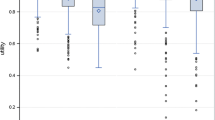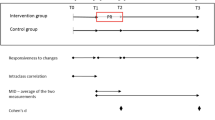Abstract
Background
Accurate assessment of preference-based health-related quality of life is important in determining the value of asthma interventions.
Objective
To examine the sensitivity and responsiveness of the EQ-5D and the AQL-5D to differences in asthma control measured by the Asthma Control Questionnaire (ACQ-5).
Methods
The Observational Study of Asthma Control and Outcomes was a prospective survey of persistent asthma patients ≥12 years old in Kaiser Colorado. Patients received a survey three times in 1 year, including the ACQ-5, AQL-5D and EQ-5D-3L (including VAS). Censored Least Absolute Deviations (CLAD) and logistic regression were used, controlling for sociodemographics and smoking.
Results
There were 6666 completed surveys (1799 individuals completed all three survey waves). After controlling for covariates, each one-point increase in ACQ-5 was associated with a decrease of 0.066, 0.058, 0.074 and 6.12 in EQ-5D(US), EQ-5D(UK), AQL-5D and VAS scores. Uncontrolled asthma (ACQ-5 > 1.5) was associated with a decrease of 0.15, 0.17, 0.11 and 10, respectively (vs. ACQ ≤ 1.5). AQL-5D scores were statistically significantly different across categories of ACQ-5 scores of 0.5 (the minimum clinically important difference [MCID]), while EQ-5D scores were not significant across most categories. The AQL-5D appeared more robust to changes in control over time (responsiveness) compared to EQ-5D-3L.
Conclusion
The AQL-5D appears more responsive to changes in asthma control over time and more sensitive to detecting differences corresponding to the ACQ-5 MCID than the EQ-5D-3L. Using the EQ-5D-3L without an asthma-specific measure such as the AQL-5D may miss clinically important changes in asthma control.



Similar content being viewed by others
References
Sullivan, P. W., Smith, K. L., Ghushchyan, V. H., Globe, D. R., Lin, S. L., & Globe, G. (2013). Asthma in USA: Its impact on health-related quality of life. Journal of Asthma, 50(8), 891–899.
Vollmer, W. M., Markson, L. E., O’Connor, E., Sanocki, L. L., Fitterman, L., Berger, M., et al. (1999). Association of asthma control with health care utilization and quality of life. American Journal of Respiratory and Critical Care Medicine, 160(5 Pt 1), 1647–1652.
Chen, H., Gould, M. K., Blanc, P. D., Miller, D. P., Kamath, T. V., Lee, J. H., et al. (2007). Asthma control, severity, and quality of life: Quantifying the effect of uncontrolled disease. Journal of Allergy and Clinical Immunology, 120(2), 396–402.
Siroux, V., Boudier, A., Anto, J. M., Cazzoletti, L., Accordini, S., Alonso, J., et al. (2008). Quality-of-life and asthma-severity in general population asthmatics: Results of the ECRHS II Study. Allergy, 63(5), 547–554.
Cockcroft, D. W., & Swystun, V. A. (1996). Asthma control versus asthma severity. Journal of Allergy and Clinical Immunology, 98(6 Pt 1), 1016–1018.
Pakhale, S., Mulpuru, S., & Boyd, M. (2011). Optimal management of severe/refractory asthma. Clinical Medicine Insights Circulatory, Respiratory and Pulmonary Medicine, 5, 37–47.
Rosenzweig, J. R. C., Edwards, L., Lincourt, W., Dorinsky, P., & ZuWallack, R. L. (2004). The relationship between health-related quality of life, lung function and daily symptoms in patients with persistent asthma. Respiratory Medicine, 98(12), 1157–1165.
Juniper, E. F., O’Byrne, P. M., Guyatt, G. H., Ferrie, P. J., & King, D. R. (1999). Development and validation of a questionnaire to measure asthma control. European Respiratory Journal, 14(4), 902–907.
Guyatt, G. H., Osoba, D., Wu, A. W., Wyrwich, K. W., & Norman, G. R. (2002). Methods to explain the clinical significance of health status measures. Mayo Clinic Proceedings, 77(4), 371–383.
McTaggart-Cowan, H. M., Marra, C. A., Yang, Y., Brazier, J. E., Kopec, J. A., FitzGerald, J. M., et al. (2008). The validity of generic and condition-specific preference-based instruments: the ability to discriminate asthma control status. Quality of Life Research, 17(3), 453–462.
Moy, M. L., Fuhlbrigge, A. L., Blumenschein, K., Chapman, R. H., Zillich, A. J., Kuntz, K. M., et al. (2004). Association between preference-based health-related quality of life and asthma severity. Annals of Allergy, Asthma & Immunology, 92(3), 329–334.
Nishimura, K., Oga, T., Ikeda, A., Hajiro, T., Tsukino, M., & Koyama, H. (2008). Comparison of health-related quality of life measurements using a single value in patients with asthma and chronic obstructive pulmonary disease. Journal of Asthma, 45(7), 615–620.
Sullivan, P. W., Campbell, J. D., Globe, G., Ghushchyan, V. H., Bender, B., Schatz, M., et al. (2015). Measuring the effect of asthma control on exacerbations and health resource use. Journal of Allergy and Clinical Immunology, 136(5), 1409.e6–1411.e6
Juniper, E. F., Buist, A. S., Cox, F. M., Ferrie, P. J., & King, D. R. (1999). Validation of a standardized version of the Asthma Quality of Life Questionnaire. Chest, 115(5), 1265–1270.
QOLTECH. Asthma Control Questionnaire 2010 [cited 2010 March 5 2010]. http://www.qoltech.co.uk/acq.html.
Juniper, E. F., Gruffydd-Jones, K., Ward, S., & Svensson, K. (2010). Asthma Control Questionnaire in children: validation, measurement properties, interpretation. European Respiratory Journal, 36(6), 1410–1416.
Juniper, E. F., Svensson, K., Mork, A. C., & Stahl, E. (2005). Measurement properties and interpretation of three shortened versions of the asthma control questionnaire. Respiratory Medicine, 99(5), 553–558.
Juniper, E. F., Bousquet, J., Abetz, L., & Bateman, E. D. (2006). Identifying ‘well-controlled’ and ‘not well-controlled’ asthma using the Asthma Control Questionnaire. Respiratory Medicine, 100(4), 616–621.
Brooks, R. G., Jendteg, S., Lindgren, B., Persson, U., & Bjork, S. (1991). EuroQol: health-related quality of life measurement. Results of the Swedish questionnaire exercise. Health Policy, 18(1), 37–48.
Shaw, J. W., Johnson, J. A., Coons, S. J. (2005). U.S. valuation of the EQ-5D health states: development and testing of the D1 valuation model. Medical Care, 43(3), 203–220
The EuroQol Group. EQ-5D Reference Search 2016 [cited 2013 May 10]. http://www.euroqol.org/eq-5d-publications/search.html.
Pickard, A. S., Wilke, C., Jung, E., Patel, S., Stavem, K., & Lee, T. A. (2008). Use of a preference-based measure of health (EQ-5D) in COPD and asthma. Respiratory Medicine, 102(4), 519–536.
Noyes, J., & Edwards, R. T. (2011). EQ-5D for the assessment of health-related quality of life and resource allocation in children: a systematic methodological review. Value Health, 14(8), 1117–1129.
Hennessy, S., Kind, P. (2002). Measuring health status in children: Developing and testing a child-friendly version of EQ-5D. In 19th plenary meeting of the EuroQol Group; York, United Kingdom.
Wille, N., Badia, X., Bonsel, G., Burstrom, K., Cavrini, G., Devlin, N., et al. (2010). Development of the EQ-5D-Y: A child-friendly version of the EQ-5D. Quality of Life Research, 19(6), 875–886.
Dolan, P. (1997). Modeling valuations for EuroQol health states. Medical Care, 35(11), 1095–1108.
Juniper, E. F., Guyatt, G. H., Cox, F. M., Ferrie, P. J., & King, D. R. (1999). Development and validation of the Mini Asthma Quality of Life Questionnaire. European Respiratory Journal, 14(1), 32–38.
Young, T. A., Yang, Y., Brazier, J. E., & Tsuchiya, A. (2011). The use of rasch analysis in reducing a large condition-specific instrument for preference valuation: the case of moving from AQLQ to AQL-5D. Medical Decision Making, 31(1), 195–210.
Yang, Y., Brazier, J. E., Tsuchiya, A., & Young, T. A. (2011). Estimating a preference-based index for a 5- dimensional health state classification for asthma derived from the asthma quality of life questionnaire. Medical Decision Making, 31(2), 281–291
Yang, Y., Brazier, J. E., Tsuchiya, A., Young, T. A. (2002). Estimating a preference-based single index from the Asthma Quality of Life Questionnaire (AQLQ). Sheffield: Health Economics and Decision Science (HEDS) Section at the School of Health and Related Research (ScHARR), University of Sheffield, 07/02. Report No.
Juniper, E. F., Svensson, K., Mork, A. C., & Stahl, E. (2005). Modification of the asthma quality of life questionnaire (standardised) for patients 12 years and older. Health Qual Life Outcomes, 3, 58.
Sullivan, P. W., Lawrence, W. F., & Ghushchyan, V. (2005). A national catalog of preference-based scores for chronic conditions in the United States. Medical Care, 43(7), 736–749.
Efron, B., & Tibshirani, R. J. (1986). Bootstrap methods for standard errors, confidence intervals, and other measures of statistical accuracy. Statistical Science, 1, 54–77.
Acknowledgments
The authors thank Denise Globe, PhD for her valuable contribution to the conception and design of the study. Funding source: This study was funded by Amgen Inc.
Author information
Authors and Affiliations
Corresponding author
Appendix
Rights and permissions
About this article
Cite this article
Sullivan, P.W., Ghushchyan, V.H., Campbell, J.D. et al. Measurement of utility in asthma: evidence indicating that generic instruments may miss clinically important changes. Qual Life Res 25, 3017–3026 (2016). https://doi.org/10.1007/s11136-016-1357-8
Accepted:
Published:
Issue Date:
DOI: https://doi.org/10.1007/s11136-016-1357-8




